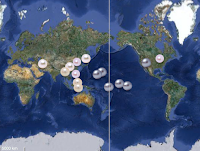 Ancient
premonitions about 2012 have penetrated pop culture (Hollywood not
withstanding) and hung a dark, ominous cloud over the coming year. However, the marine conservation community
isn’t letting the Mayans get them down.
As evidence mounts for a dramatically changing climate, growing impacts of development,
and continued resource exploitation, researchers and practitioners will be
looking to promote their causes and make it a big year for the oceans. Within the government, strategic planning and
annual guidance developed years in advance help prioritize activities and
projects.
Ancient
premonitions about 2012 have penetrated pop culture (Hollywood not
withstanding) and hung a dark, ominous cloud over the coming year. However, the marine conservation community
isn’t letting the Mayans get them down.
As evidence mounts for a dramatically changing climate, growing impacts of development,
and continued resource exploitation, researchers and practitioners will be
looking to promote their causes and make it a big year for the oceans. Within the government, strategic planning and
annual guidance developed years in advance help prioritize activities and
projects.  For
NOAA, some of these priorities will include improving the capacity for science
and energy development in the Arctic, evaluating newly implemented fisheries
catch share programs, and enhancing the nation’s ability to prepare for and
recover from extreme weather events.
Despite slim budgets, agencies and organizations around the country will
pursue such diverse conservation issues ranging from illegal fishing, protecting
corals, and studying ocean acidification.
Perhaps one positive outcome of budget shortfalls will be greater
collaboration and teamwork. Regardless,
we wish for a good year for our world’s oceans, lakes, and coasts.
For
NOAA, some of these priorities will include improving the capacity for science
and energy development in the Arctic, evaluating newly implemented fisheries
catch share programs, and enhancing the nation’s ability to prepare for and
recover from extreme weather events.
Despite slim budgets, agencies and organizations around the country will
pursue such diverse conservation issues ranging from illegal fishing, protecting
corals, and studying ocean acidification.
Perhaps one positive outcome of budget shortfalls will be greater
collaboration and teamwork. Regardless,
we wish for a good year for our world’s oceans, lakes, and coasts.
Got
any good New Year’s Resolutions for 2012?
In case you’re lacking inspiration, doubt your own resolve, or worry
about commitment, here are a few simple things you can do for the ocean.
- Learn your local recycling rules. In DC, we can recycle most everything, but find guidance here.
- Take reusable (or re-use plastic) bags to the market for fruits and veggies.
- Make a donation to one of the numerous NGOs for an annual membership and put it on your resume to advertise your loyalties.
- Take eating utensils to the cafeteria – each fork matters!
- And lastly and perhaps the most fun, talk with your friends and family about the ocean and coasts, and stay up-to-date by talking to us fellows about our numerous conservation and management projects!

These
simple activities will remind you why we’re all living miles away from the
ocean and perhaps inspire our friends and family to think about the connections
between human activities and environmental health the next time they take a
seaside walk or coastal hike.
Happy
New Year!











































